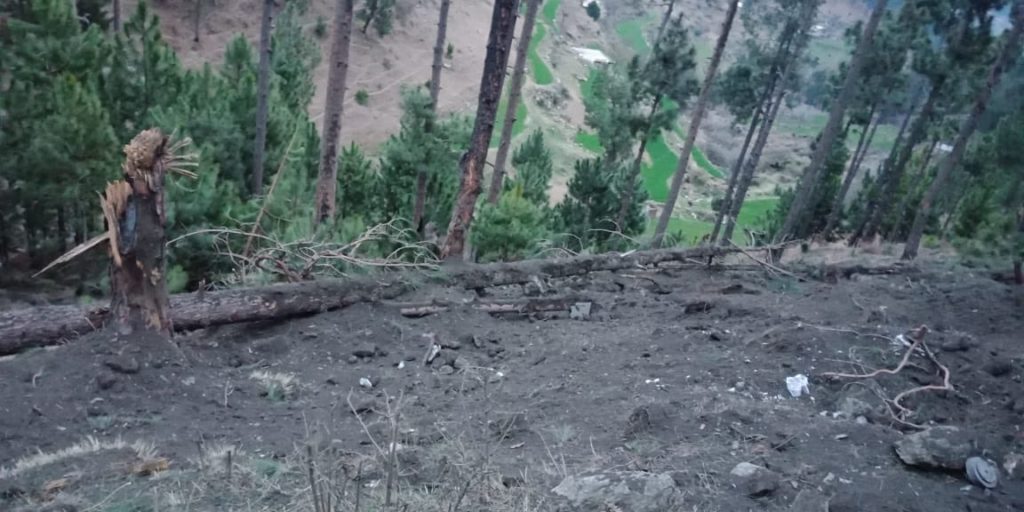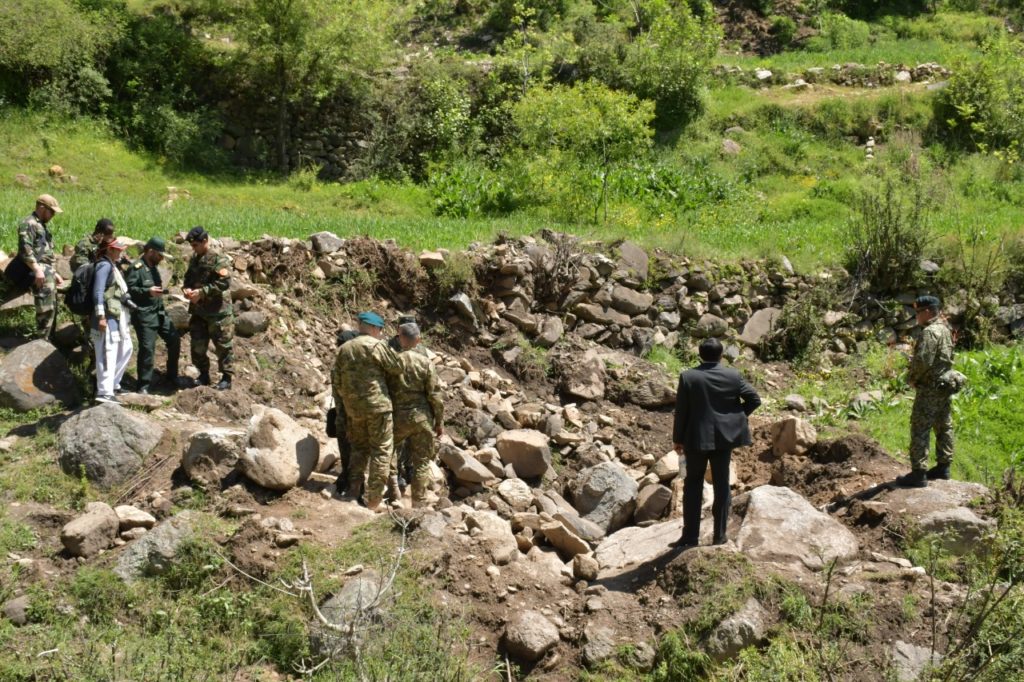Pakistan
PAF’s Operation Swift Retort – Feb 27 Continues to haunt IAF
Published
3 years agoon
By
EDITOR
(APP) Three years after the downing of two Indian Air Force aircraft and capture of one pilot, the IAF is yet to recover from the humiliation at the hands of a far smaller adversary – the PAF which exposed to the world the inherent military weakness of a “nuclear-armed” India.
The Indian botched attempt to strike deep inside Pakistan following a false flag operation at Pulwama, and counter strike by the PAF on Feb 27 established its military and technological superiority, shattering to pieces the myth of Indian military might.
On 14 February 2019, a young Kashmiri boy, resenting Indian oppression of Kashmiri people, drove a vehicle packed with explosives into a convoy of 78 buses carrying Indian paramilitary police in Pulwama, killing 40 CRPF personnel. Moments after the attack the Indian media and government immediately blamed Pakistan before even the start of any investigation.
Prime Minister Khan promised to conduct an investigation, provided Delhi could provide any “actionable evidence.” He however also warned that Pakistan would “retaliate” if attacked. Nevertheless, the Indians opted to carry out an airstrike across the border on an imaginary terrorist training camp on the Pakistani side
Indian Military Plans strike across border – Code Name “Bandar”
The Indian authorities code-named the attack on Balakot as “Operation Bandar” to minimize the chances of leaking the news. The word “Bandar” was chosen because monkeys enjoy a sacred place in the Hindu religion and this refers to a tale in the religious myths of Hinduism where Hanuman – a deity who shows resemblance to the monkey – secretly entered Lanka and burned it to the ground.
Feb 26, 2019 – IAF Strikes inside Pakistan near Balakot
The Indian Air Force launched an aerial strike near ‘Balakot’ On Feb 26, 2019, targeting a religious seminary that India described as a militant camp, and claimed killing more than 300 terrorists but without sharing any shred of evidence to corroborate the claims.
The well-rehearsed operation involving 20 Mirage 2000 aircrafts carrying Spice 2000 and Crystal Maze missiles had the support of Air Borne Early Warning systems. They failed to deliver their payload on the target despite practising on the simulator and pre-fed coordinates on the bombs.
According to Hindustan Times on February 26, 2019, at 3.45 am the then Air Chief BS Dhanoa made a telephone call to National Security Adviser Ajit Doval on a secure fixed-line network and said “Bandar mara gaya” – “The monkey has been killed,” but at the end of the day, the reality proved that they just made a monkey of themselves.
Indian aircrafts intruded from Muzafarabad sector. Facing timely and effective response from Pakistan Air Force released payload in haste while escaping which fell near Balakot. No casualties or damage.
— DG ISPR (@OfficialDGISPR) February 26, 2019
Following the strike Prime Minister Imran Khan in a hard-hitting statement categorically said “India has committed uncalled-for aggression to which Pakistan shall respond at the time and place of its choosing … Armed Forces and the people of Pakistan to remain prepared for all eventualities.”
The Indian aircraft dropped their payload near a hillside, killing one crow and damaging a few precious pine trees, an act which prompted Prime Minister Imran Khan to repeatedly say that he was very hurt, as trees were very close to his heart.

Military attache’ and foreign media also later visited the site and also went to the nearby madrassa of local village children, who were lucky enough to escape the Indian recklessness.
India claimed that its air force had managed to kill more than 300 terrorists while Pakistan but several international observers negated the claim as there were no casualties and the bombs had clearly missed the target, which in fact was not a terrorist camp, but an ordinary religious school, for the village children.
“The Pakistanis are bound to react, conventionally and not through a proxy like a militant group,” Rahul Bedi, an analyst at the London-based Jane’s Information Group told the New York Times. “Where they react and when is something that only Pakistanis know.”
The newspaper pointed out that in the run-up to Indian elections this spring, and with Modi facing a fierce re-election fight, voters have demanded that New Delhi respond to the Kashmir attack with force against Pakistan.
“What they hit is speculation for now,” Bedi said. “This is more political symbolism than anything else. Mr. Modi had to show some demonstrable action on India’s part, ahead of elections.”

Feb 27, 2019 – PAF carries out Operation Swift Retort
In response, Pakistan Air Force launched a counter-strike on Feb 27, 2019, intended primarily to demonstrate Pakistan’s resolve. The strike was carefully crafted to avoid casualties on the ground.
During the short aerial encounter that followed, PAF shot down two IAF aircraft and captured one of the pilots. The debris of the SU-30 fell in IOK and its pilot was killed, while the MiG-21 pilot Wing Commander Abhinandan Varthaman, whose aircraft fell on the Pakistan side was captured alive.
The success of the Pakistan Air Force in Operation Swift Retort against a far bigger adversary is now observed as a “Surprise Day” every year.
In response to PAF strikes this morning as released by MoFA, IAF crossed LOC. PAF shot down two Indian aircrafts inside Pakistani airspace. One of the aircraft fell inside AJ&K while other fell inside IOK. One Indian pilot arrested by troops on ground while two in the area.
— DG ISPR (@OfficialDGISPR) February 27, 2019

Hours later the jittery Indian Air Force IAF shot down its own Mi-17 helicopter with SPYDER air defense system killing six Air Force personnel and one civilian. India claimed that one of its Mig-21s shot down Pakistan’s F-16 aircraft which was also refuted by the influential Foreign Policy magazine based on interviews with the US Department of Defence (DoD) officials who verified that no F-16 was missing from the Pakistani inventory.
According to the magazine, Pakistan invited the US to physically count its F-16 planes after the incident as part of an end-user agreement signed when the foreign military sale was finalized.
Some of the aircraft were not immediately available for inspection due to the conflict, so it took US personnel several weeks to account for all of the jets, one US official said.
But now the count has been completed, and “all aircraft were present and accounted for,” the official said.”

While the Indian so-called surgical strike was being touted by India as a great success and declared as a ‘new norm’, but on the other hand, India’s senior leadership blamed the failure on the non-availability of aircraft like Rafale, which according to them would have changed the outcome of Balakot crisis.
Even the Indian Prime Minister Narendra Modi admitted the failure of his Air Force and while speaking at the India Today event said “Today, all of India is saying that if we had the Rafale, then the result would have been different.”
Pakistan’s response was intended to deter war and establish nuclear deterrence, the success of which could be gauged by the fact that India could not move up the escalation ladder and backed down. of one Indian pilot, Wing Commander Abhinandan Varthaman. The skirmish proved PAF’s air superiority over IAF but also restored conventional strategic balance between the two nuclear-armed powers.
#Pakistanstrikesback #PAF undertook strikes across LoC from Pakistani airspace. Sole purpose of this action was to demonstrate our right, will and capability for self defence. We do not wish to escalate but are fully prepared if forced into that paradigm#PakistanZindabad
— Spokesperson 🇵🇰 MoFA (@ForeignOfficePk) February 27, 2019
On Feb 27, the military’s media wing said Pakistan Air Force had engaged six targets at the LoC. Maj Gen Ghafoor termed it a conscious decision not to attack any military target and avoid any collateral damage. He said one of the targets initially picked was a military administrative complex, however, the PAF command decided against hitting it.
“As a result of engaging our targets, no human life was affected. Staying within our jurisdiction, six targets were locked. And we carried out the strike,” he said.
He said the objective of the strikes was to show “we have the capacity and the will to respond, but we deliberately avoided the escalation path.”
“Pakistan is not pushing for war. We engaged our targets in open air, we deliberately avoided escalation. We could easily have taken the original targets, but we did not do that,” the DG ISPR said.
Feb 28, 2019 – Prime Minister Imran Khan orders release of Abhinandan as “Peace Gesture”
A day later Prime Minister Imran Khan in his address to a joint parliamentary session on Feb 28, 2019, said; “In our desire for peace, I announce that tomorrow, and as a first step to open negotiations, Pakistan will be releasing the Indian Air Force officer in our custody.” His decision was hailed by top world leaders as a great peace gesture.
March 1, 2019 – Abhinandan handed over to India
Wing Commander Abhinandan was treated well, in line with the Geneva Conventions, provided new dress and of course the famous cup of tea, on which he had remarked: “Tea was Fantastic“. He was handed over to the Indian authorities on March 1, 2019 at the Wagah border.

Defence officials say Pakistan has credible conventional responses designed to meet different contingencies – known as the policy of ‘Quid Pro Quo Plus,’ which has not only reinforced the credibility of Pakistan’s nuclear deterrence but has also helped restore confidence in conventional deterrence.
After experiencing humiliation at the hands of PAF in Feb 2019, India has gone on yet another arms and ammunition shopping spree, without realising that it is in fact the man behind the machine and his strong nerves that matter.
However, the best sum up came from DG ISPR Major General Babar Iftikhar who while giving a recap of the Feb 2019 events had said;
“WE GAVE THEM A BLOODY NOSE AND IT IS STILL HURTING”
DG ISPR Major General Babar Iftikhar
This is an updated version of the article that was published on Feb 26, 2021
You may like
Pakistan
Nation celebrates Pakistan Day today with traditional zeal
Published
2 months agoon
March 23, 2025By
EDITOR
The nation celebrates Pakistan Day on Sunday with a renewed pledge to transform the country into a true Islamic and welfare state in line with the vision of Quaid-e-Azam Muhammad Ali Jinnah.
The day is observed to commemorate the historic Lahore Resolution passed on 23rd March in 1940, under which Muslims of the Sub-continent set the agenda of a separate homeland for themselves.
The day dawned with thirty-one-gun salute in the federal capital and twenty-one-gun salute in provincial capitals.
Special prayers were offered in mosques after Fajr prayers for progress and prosperity of the country.
The special feature of the day will be Pakistan Day Military Parade in Islamabad on a limited scale at Aiwan-e-Sadr due to the month of Ramadan.
President Asif Ali Zardari will be the chief guest on the occasion.
Contingents from all the three armed forces will actively participate in the Parade.
Fighter jets from Pakistan Air Force will conduct a flypast.
Radio Pakistan and PTV are broadcasting special programmes to highlight the significance of the day and pay tribute to the leaders and workers of Pakistan Movement.
Pakistan
Pakistan Day: A Reminiscence of the Heroic Struggle of Muslims of the Subcontinent
Published
2 months agoon
March 23, 2025By
EDITOR
Pakistan Day, observed annually on March 23rd, holds a place of immense significance in the history of Pakistan. It marks the passing of the Lahore Resolution in 1940, which laid the foundation for the creation of an independent state for Muslims of the Indian subcontinent. This historic day serves as a reminder of the heroic struggle, sacrifices, and unwavering resolve of the Muslims who aspired for a separate homeland where they could live with dignity and practice their religion freely.
The Lahore Resolution: A Milestone in the Freedom Struggle
The All India Muslim League, under the leadership of Quaid-e-Azam Muhammad Ali Jinnah, convened its annual session in Lahore from March 22 to 24, 1940. On March 23rd, the historic resolution was passed at Minto Park (now known as Iqbal Park), demanding separate states for Muslims in the northwestern and eastern regions of India. This resolution, often referred to as the “Pakistan Resolution,” became the cornerstone of the Pakistan Movement and galvanized Muslims into an organized struggle for their rights.
The Heroic Struggle and Sacrifices of the Muslims
The road to independence was not an easy one. The Muslims of the subcontinent faced tremendous challenges, including political opposition, social hardships, and economic constraints. The demand for a separate homeland was met with strong resistance from both the British colonial rulers and the Indian National Congress. However, the unwavering commitment of Muslim leaders and activists fueled the movement with newfound energy and resilience.
Quaid-e-Azam Muhammad Ali Jinnah, through his unmatched leadership and unwavering determination, guided the Muslims towards their goal. He emphasized the importance of unity, faith, and discipline, inspiring millions to rally behind the cause. Countless individuals sacrificed their lives, endured imprisonment, and faced brutal oppression, all for the dream of an independent Pakistan.
The Creation of Pakistan: A Dream Realized
The struggle for independence culminated in the emergence of Pakistan on August 14, 1947. The dream envisioned in the Lahore Resolution turned into a reality, marking the beginning of a new era for the Muslims of the subcontinent. The creation of Pakistan was not just the establishment of a new country; it was the fulfillment of a long-cherished aspiration for freedom, identity, and sovereignty.
Pakistan Day: A Tribute to the Nation’s Heroes
March 23rd is celebrated with great enthusiasm across Pakistan. The day begins with special prayers for the prosperity and security of the country, followed by military parades, flag-hoisting ceremonies, and cultural events. The highlight of the day is the grand parade in Islamabad, where the armed forces display their prowess, and national leaders pay tribute to the sacrifices of the past.
Pakistan Day serves as a moment of reflection and gratitude. It reminds the nation of the core principles that led to the creation of Pakistan—unity, faith, and discipline. It is also a call to action for the younger generation to uphold the values of hard work, patriotism, and national integrity to ensure a prosperous future for the country.
Pakistan Day is more than just a historical milestone; it is a testament to the resilience and determination of the Muslims of the subcontinent. It is a day to honor the sacrifices of the past and reaffirm the commitment to building a strong and progressive Pakistan. As the nation moves forward, it must continue to uphold the principles of justice, equality, and unity that were at the heart of the Pakistan Movement.
May Pakistan continue to shine as a beacon of hope, strength, and prosperity for generations to come. Pakistan Zindabad!

The Chiltan Ibex: A Rare Treasure of Balochistan

MANGO HEALTH BENEFITS NUTRITION









